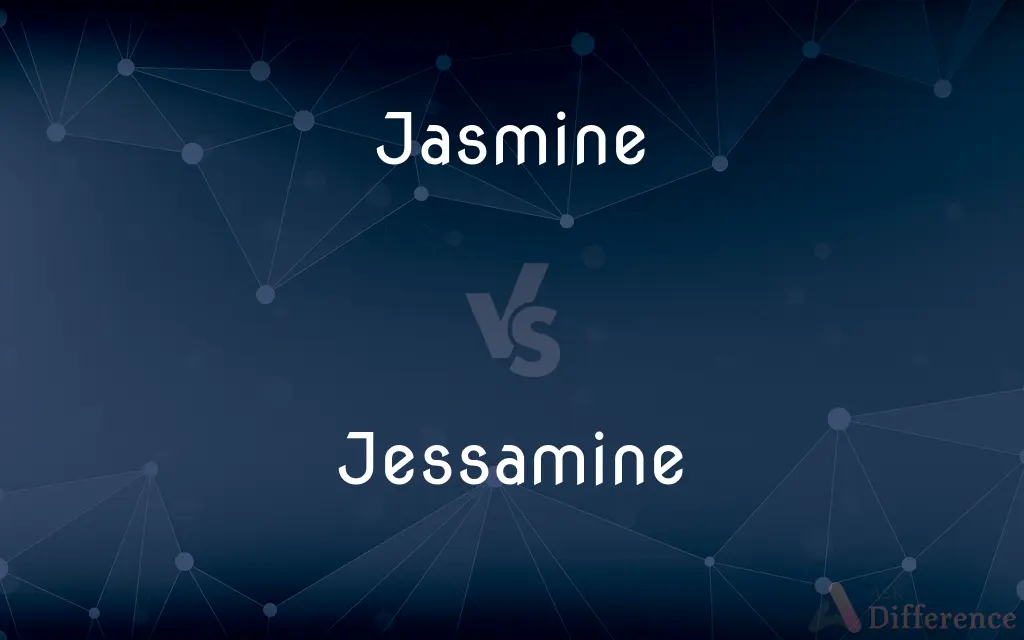Jasmine vs. Jessamine — What's the Difference?
By Urooj Arif & Maham Liaqat — Updated on March 30, 2024
Jasmine and Jessamine are terms often used interchangeably to describe fragrant flowers from the genus Jasminum. The difference mainly lies in regional language preferences, with "Jasmine" being more globally recognized.

Difference Between Jasmine and Jessamine
Table of Contents
ADVERTISEMENT
Key Differences
The term "Jasmine" is widely used across the world to refer to the aromatic flowers of the Jasminum genus, known for their sweet scent and beautiful white or yellow blooms. These flowers are popular in gardens and as houseplants due to their appealing fragrance and appearance. On the other hand, "Jessamine" is a less commonly used term that often refers to the same plants within the Jasminum genus, particularly in certain English-speaking regions. It's essentially an older or more poetic name for jasmine, reflecting regional linguistic preferences rather than botanical distinctions.
Both jasmine and jessamine are celebrated for their intoxicating fragrance, which is used in perfumes, teas, and traditional ceremonies around the world. While the terms might suggest a difference, they generally refer to the same plant species and share the same uses and cultural significance. However, in some contexts, "jessamine" might be specifically used to describe native or naturalized species in certain regions, emphasizing a local connection or preference.
In cultivation and care, jasmine (or jessamine) plants require similar conditions: well-drained soil, regular watering, and ample sunlight. They are prized for their delicate flowers, which not only enhance garden aesthetics but also attract pollinators. Whether labeled as jasmine or jessamine in garden centers or botanical texts, the care guidelines and environmental requirements remain consistent, underscoring the terms' interchangeability in practical horticulture.
Though synonymous in many ways, the preference for "jasmine" over "jessamine" in popular culture and commercial use highlights the former's broader recognition. This can be seen in the naming of products, from fragrances to teas, where "jasmine" is preferred for its widespread familiarity. Nonetheless, the use of "jessamine" persists in certain literary and historical contexts, offering a nod to the rich linguistic tapestry surrounding these beloved plants.
Comparison Chart
Botanical Reference
Refers to plants in the Jasminum genus
Often the same, especially in certain English-speaking regions
ADVERTISEMENT
Usage
More commonly used globally
Less common, with a regional or poetic preference
Fragrance
Sweet and highly fragrant
Identical, as it refers to the same plants
Flower Color
Typically white or yellow
Same as Jasmine
Cultural Significance
Used widely in perfumes, teas, and ceremonies
Same significance, though the term may highlight regional identity
Cultivation Requirements
Well-drained soil, regular watering, ample sunlight
Identical to Jasmine
Compare with Definitions
Jasmine
Used in perfumery and tea flavoring due to its sweet fragrance.
Jasmine tea is favored for its soothing aroma.
Jessamine
An alternative name for the jasmine plant, used in certain locales.
The garden was adorned with blooming jessamine.
Jasmine
A plant of the genus Jasminum, known for its fragrant white or yellow flowers.
The jasmine vine by the window filled the room with its scent.
Jessamine
Retains a place in historical and literary contexts, symbolizing affection and warmth.
Jessamine in folklore is associated with good fortune.
Jasmine
Requires specific horticultural care to thrive.
Planting jasmine in well-drained soil ensures healthy growth.
Jessamine
Sometimes emphasizes a regional or poetic preference.
Old poems celebrate the charm of jessamine.
Jasmine
Symbolizes purity, simplicity, and grace in various cultures.
Jasmine flowers are often used in wedding ceremonies.
Jessamine
Shares the same uses as jasmine, including in aromatherapy and decoration.
The scent of jessamine is believed to relieve stress.
Jasmine
Featured in literature and art as a symbol of love and beauty.
Poets often compare their beloved's beauty to that of jasmine.
Jessamine
Cultivation and care mirror that of jasmine plants.
Jessamine thrives in sunny spots with regular watering.
Jasmine
Jasmine (taxonomic name Jasminum YASS-min-əm) is a genus of shrubs and vines in the olive family (Oleaceae). It contains around 200 species native to tropical and warm temperate regions of Eurasia and Oceania.
Jessamine
Variant of jasmine.
Jasmine
An Old World shrub or climbing plant which is popular as an ornamental and bears fragrant white, pink, or yellow flowers.
Jessamine
Same as Jasmine.
Jasmine
Any of several vines or shrubs of the genus Jasminum, native chiefly to Asia and having usually compound leaves and white or yellow flowers. Some of the fragrant species are used in making perfume.
Jessamine
Tall-climbing deciduous shrub with fragrant white or yellow or red flowers used in perfume and to flavor tea
Jasmine
The perfume obtained from these plants.
Jasmine
See yellow jessamine.
Jasmine
Any of several plants or shrubs having fragrant flowers.
Jasmine
A light to brilliant yellow.
Jasmine
Any of several plants, of the genus Jasminum, mostly native to Asia, having fragrant white or yellow flowers.
Jasmine
The perfume obtained from these plants.
Jasmine
Any of several not closely related plants having a similar perfume.
Jasmine
A yellow colour.
Jasmine
A shrubby plant of the genus Jasminum, bearing flowers of a peculiarly fragrant odor. The Jasminum officinale, common in the south of Europe, bears white flowers. The Arabian jasmine is Jasminum Sambac, and, with Jasminum angustifolia, comes from the East Indies. The yellow false jasmine in the Gelseminum sempervirens (see Gelsemium). Several other plants are called jasmine in the West Indies, as species of Calotropis and Faramea.
Jasmine
Any of several shrubs and vines of the genus Jasminum chiefly native to Asia
Common Curiosities
Which term should I use when purchasing a plant or seeds?
"Jasmine" is more widely recognized in commercial and gardening contexts, but either term is correct.
Do jasmine and jessamine have the same fragrance?
Yes, as they refer to the same plant, the fragrance is identical and highly valued in both cases.
Are there any cultural differences in the use of jasmine vs. jessamine?
The use of "jessamine" may reflect regional identity or historical preference, while "jasmine" is more universally understood.
Is there a botanical difference between jasmine and jessamine?
No, both terms refer to the same genus of plants, Jasminum, and the differences are primarily linguistic.
How do I care for a jasmine/jessamine plant?
Care requirements are the same: well-drained soil, regular watering, and plenty of sunlight.
How do poets and writers differentiate between jasmine and jessamine?
The choice between jasmine and jessamine in literature often depends on the author's stylistic preference or the historical period they're depicting.
Can I use jasmine and jessamine interchangeably in gardening?
Yes, since they refer to the same plants, gardening advice applies equally to both.
Can both jasmine and jessamine be used for tea flavoring?
Yes, the flowers of these plants are commonly used to flavor tea, offering a sweet, soothing aroma.
Are jasmine and jessamine plants easy to grow?
They can be, provided they're given the right conditions like ample sunlight and well-drained soil.
Is there a difference in the symbolic meaning of jasmine and jessamine?
Symbolically, they carry the same meanings of purity, love, and beauty across various cultures.
Is jessamine used in any specific cultural or traditional practices?
While specific practices may vary, both jasmine and jessamine hold similar cultural significance and are used in traditional ceremonies and perfumery.
Why is jessamine less commonly used than jasmine?
"Jasmine" has gained broader international recognition, while "jessamine" remains more regionally or historically preferred.
Why might someone prefer to use the term jessamine over jasmine?
Personal or regional preference, historical accuracy in writing, or a desire to evoke a specific literary or poetic feeling might influence this choice.
Do jasmine and jessamine flowers bloom at the same time?
Yes, given that they refer to the same species, their blooming period is generally the same.
Can jasmine and jessamine be found in wild, or are they primarily cultivated?
Both can be found in the wild in their native habitats, as well as being widely cultivated in gardens and homes for their beauty and fragrance.
Share Your Discovery

Previous Comparison
Expect vs. Required
Next Comparison
Fettuccine vs. FettucciniAuthor Spotlight
Written by
Urooj ArifUrooj is a skilled content writer at Ask Difference, known for her exceptional ability to simplify complex topics into engaging and informative content. With a passion for research and a flair for clear, concise writing, she consistently delivers articles that resonate with our diverse audience.
Co-written by
Maham Liaqat













































